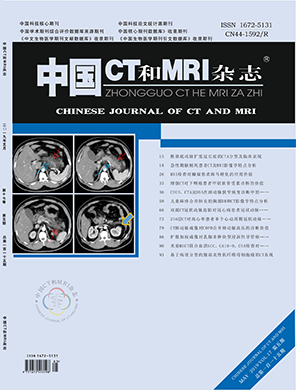论著-头颈部
数字减影CT血管成 像和低场强MRI诊断 蛛网膜下腔出血的 价值及影像特点分 析
作者:曹福媛1 陈燕浩2 余 波1
所属单位:1.华中科技大学同济医学院附属 武汉中心医院急诊科 2.华中科技大学同济医学院附属 武汉中心医院影像科 (湖北 武汉 430014)
PDF摘要
目的 数字减影CT血管成像 (DSCTA)和低场强MRI诊断蛛网膜下腔出血 (SAH)的价值及影像特点分析。方法 选 择2014年1月到2018年1月到医院就诊SAH 患者85例,所有患者均进行DSCTA、低场 强MRI检查。以脑血管造影(DSA)为金标 准,统计DSCTA及低场强MRI诊断效能,统 计DSCTA及低场强MRI对不同病因SAH检出 率,统计DSCTA及低场强MRI对不同部位动 脉瘤检出率,统计DSCTA及低场强MRI对不 同大小动脉瘤检出率。结果 DSCTA对SAH 诊断准确率92.94%,特异度80.00%,灵敏 度93.75%;低场强MRI对SAH诊断准确率 90.59%,特异度80.00%,灵敏度91.25%; DSCTA在颅内动脉瘤检出率高于低场强 MRI(P<0.05);DSCTA及低场强MRI两种检 测方式在不同部位、大小动脉瘤检出率差 异无统计学意义(P>0.05)。结论 DSCTA 及低场强MRI均对SAH有较高诊断效能,其 中DSCTA可提升血管对比度且可去除骨结 构干扰,对动脉瘤检出率更高。
Objective To analyze the value and imaging features of digital subtraction CT angiography (DSCTA) and low field intensity MRI in the diagnosis of subarachnoid hemorrhage (SAH). Methods 85 cases of patients with SAH in the hospital from January 2014 to January 2018 were selected. All patients were given DSCTA and low field intensity MRI. The cerebral angiography (DSA) was taken as the gold standard, and the diagnostic efficacy of DSCTA and low field intensity MRI was counted, and the detection rates of SAH with different causes were counted by DSCTA and low field intensity MRI, and the detection rates of different sites of aneurysms by DSCTA and low field intensity MRI were counted, and the detection rates of different sizes of aneurysms by DSCTA and low field intensity MRI were counted. Results The diagnostic accuracy, specificity and sensitivity of DSCTA for SAH were 92.94%, 80.00% and 93.75% respectively. The diagnostic accuracy, specificity and sensitivity of low field intensity MRI for SAH were 90.59%, 80.00% and 91.25%. The detection rate of intracranial aneurysm by DSCTA was higher than that of low field intensity MRI (P<0.05). There were no significant differences in the detection rates of aneurysms of different sites and sizes by DSCTA and low field intensity MRI (P>0.05). Conclusion Both DSCTA and low field intensity MRI have high diagnostic efficacy for SAH. DSCTA can improve blood vessel contrast and remove bone structure interference, and has high detection rate of aneurysms.
【关键词】数字减影电子计算机断层扫描 血管成像;低场强磁共振成 像;蛛网膜下腔出血
【中图分类号】R743.35
【文献标识码】A
【DOI】 10.3969/j.issn.1672- 5131.2019.05.004
前言
蛛网膜下腔出血(SAH)是指患者脑组织底部或表面发生病变血管破 裂,血液流入蛛网膜下腔导致的一种综合征,病死率高达40%,存活患 者中超过50%留存不同程度神经系统残疾,对患者生命健康造成极大 损害[1]。引起脑出血的病因均可导致SAH,包括颅内动脉瘤、脑血管畸 形、脑底异常血管网病等,其中颅内动脉瘤占比50%以上[2]。SAH确诊 后需尽快进行病因确诊,一旦确认为颅内动脉瘤破裂则应尽快进行手 术或介入治疗[3]。因此,SAH病因诊断对治疗方案选取十分关键。脑血 管造影(DSA)是诊断脑部血管疾病金标准,阳性率在95%以上,但其为 有创检查,有一定风险[4];数字减影CT血管成像(DSCTA)基于CT血管成 像发展出新型检查方式,可去除骨结构带来干扰,提升诊出率[5];低 场强MRI在过去对SAH诊断价值不大,但随着液体衰减反转恢复(FLAIR) 序列应用,其对SAH诊断价值逐渐显露出优越性[6]。基于此本研究采用 DSCTA及低场强MRI诊断SAH,旨在比较两种检测方式诊断价值。
中国CT和MRI杂志
第17卷, 第 5 期
2019年05月

相关文章